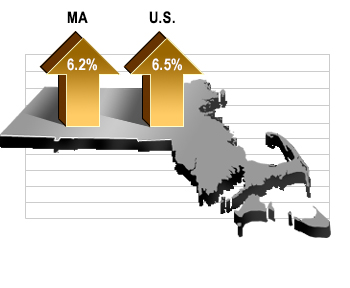State economic recovery continues, UMass journal reports
Strong economic performance locally and nationally reflects demand spurred by the Federal American Rescue Plan
July 2021
» Download the detailed report
 In the second quarter of 2021, Massachusetts real gross domestic product (GDP) increased at a 6.2 percent annualized rate, according to MassBenchmarks, while U.S. GDP increased at a 6.5 percent rate according to the U.S. Bureau of Economic Analysis (BEA). In the first quarter of 2021, Massachusetts real GDP increased at a 6.9 percent annualized rate of growth, while U.S. GDP increased at a 6.3 percent rate according to the BEA.
In the second quarter of 2021, Massachusetts real gross domestic product (GDP) increased at a 6.2 percent annualized rate, according to MassBenchmarks, while U.S. GDP increased at a 6.5 percent rate according to the U.S. Bureau of Economic Analysis (BEA). In the first quarter of 2021, Massachusetts real GDP increased at a 6.9 percent annualized rate of growth, while U.S. GDP increased at a 6.3 percent rate according to the BEA.
“This strong economic performance in both the state and the nation reflects the strong demand spurred by the American Rescue Plan, both for spending by consumers and hiring by employers, an expansionary monetary policy, and the opening of the economy aided by vaccinations,” noted Alan Clayton-Matthews, MassBenchmarks’ Senior Contributing Editor and Professor Emeritus of Economics and Public Policy at Northeastern University, who compiles and analyzes the Current and Leading Indexes. “Economic growth is expected to remain strong in the second half of the year, but there is a risk that rising COVID-19 Delta variant cases could slow the recovery,” Clayton-Matthews added.
Labor market conditions continued to improve. Payroll employment in Massachusetts grew at 4.3 percent annual rate in the second quarter, slightly slower than the 4.7 percent rate for the U.S. In the first quarter of this year, Massachusetts employment grew at a 6.9 percent rate versus a 2.1 percent rate for the U.S. Relative to the second quarter of last year, payroll employment was up by 11.3 percent in Massachusetts and 8.5 percent for the U.S. The larger growth for Massachusetts relative to the nation reflects the deeper hole that the state was in due to a more stringent shutdown. At the same time, Massachusetts has farther to go to return to pre-pandemic levels of employment. State payroll employment in June was still 7.4 percent below the February 2020 peak, while in the U.S., the gap was only 4.4 percent.
Massachusetts wage and salary income in the second quarter, estimated from state withholding taxes net of unemployment insurance withholding, grew at a 2.8 percent annual rate from the same measure in the first quarter. This understates the strength of workers’ earnings in the second quarter because the comparison in the first quarter was almost certainly boosted by a strong bonus season in the financial sector.
Relative to the second quarter of 2020, state wage and salary income was up by 15.4 percent. MassBenchmarks estimates that U.S. wage and salary income grew at an 11.5 percent annual rate in the second quarter, up 14.3 percent from the second quarter of last year. The BEA reported that wage and salary income the first quarter of this year grew at an annual rate of 5.6 percent in Massachusetts and 8.7 percent in the U.S.
Other indicators confirm that labor market conditions continued to improve for workers in the second quarter, with the Massachusetts unemployment rate falling to 4.9 percent in June from 6.7 percent in March and from 16.4 percent in the trough of the recession in April 2020. For the U.S., the unemployment rate was 5.9 percent in June, down from 6.0 percent in March and from 14.8 percent in April 2020.
The U-6 unemployment rate in June – which includes persons working part-time but who want full-time work and persons who want work but have not looked for work in the last four weeks (the “marginally attached workforce”) – was 8.9 percent in Massachusetts and 9.8 percent in the U.S. These two components of underemployment have fallen sharply in recent months in Massachusetts and are near pre-pandemic levels.
The main fuel for the economic engine in the second quarter was consumer spending. For the U.S., real personal consumption expenditures grew at an 11.8 percent annual rate in the second quarter. MassBenchmarks estimates Massachusetts spending subject to the regular state sales taxes and motor vehicle sales taxes, which reflects primarily spending on goods by consumers and businesses. This spending in Massachusetts rose by 23.1 percent in the second quarter over the first quarter, an annualized rate of 129.8 percent, 54.5 percent higher than the second quarter of last year, during the depths of the state’s shutdown. Combined with supply bottlenecks and worker shortages, this surge in spending has boosted inflation. The U.S. consumer price index rose at an 8.1 percent annual rate in the second quarter, the greatest quarterly inflation in this price index since the third quarter of 1981.
Economic growth is expected to remain strong in the second half of the year. The Massachusetts leading index is projecting state GDP growth of 4.7 percent in the third quarter and 8.1 percent in the fourth quarter. These projections do not take into account the recent uptick in COVID-19 cases related to the Delta variant or the worrying trend of slower vaccination uptake, which threaten the continued rise in consumer spending and employment across the national economy. Another constraint on sustained strong economic growth is the shortage of workers. Nationally the growth in the working-age population has slowed, and in Massachusetts the working age population has been declining since the fall of last year according to the U.S. Bureau of Labor Statistics.

